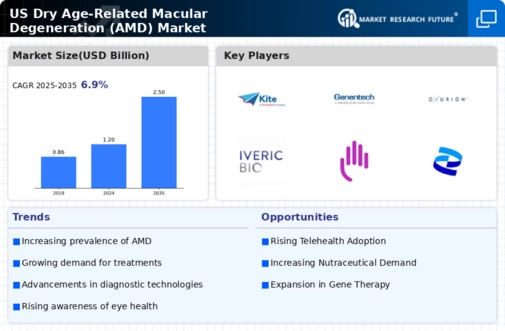Aging Population Dynamics
The demographic shift towards an older population in the US is a primary driver of the dry age-related macular degeneration (AMD) market. As individuals age, the prevalence of age-related eye diseases, including dry AMD, increases significantly. By 2030, it is projected that approximately 20% of the US population will be over 65 years old, leading to a higher incidence of AMD. This demographic trend suggests a growing need for effective treatment options and management strategies within the dry age-related-macular-degeneration-amd market. Furthermore, the aging population is likely to increase healthcare expenditures, which may further stimulate investment in research and development of new therapies and diagnostic tools tailored for this demographic. Thus, the aging population serves as a crucial catalyst for market growth.
Rising Healthcare Expenditure
In the US, healthcare expenditure continues to rise, which significantly impacts the dry age-related-macular-degeneration-amd market. In 2023, healthcare spending reached approximately $4.3 trillion, with a substantial portion allocated to eye care and vision-related treatments. This increase in spending reflects a growing recognition of the importance of addressing age-related conditions, including dry AMD. As more resources are directed towards innovative therapies and preventive measures, the market is likely to experience enhanced growth. Additionally, the willingness of patients and insurers to invest in advanced treatments may lead to a broader adoption of emerging therapies, thereby expanding the market landscape. The rising healthcare expenditure thus plays a pivotal role in shaping the future of the dry age-related-macular-degeneration-amd market.
Increased Focus on Preventive Care
The shift towards preventive care in the US healthcare system is influencing the dry age-related-macular-degeneration-amd market. Healthcare providers are increasingly emphasizing the importance of early detection and lifestyle modifications to mitigate the risk of developing AMD. This trend is supported by various public health campaigns aimed at educating the population about the risk factors associated with dry AMD, such as smoking and poor diet. As awareness grows, more individuals are likely to seek regular eye examinations and adopt healthier lifestyles, potentially reducing the incidence of AMD. Consequently, this focus on preventive care may lead to a more proactive approach in managing eye health, thereby impacting the dry age-related-macular-degeneration-amd market positively.
Advancements in Research and Development
Ongoing advancements in research and development are propelling the dry age-related-macular-degeneration-amd market forward. The US has seen a surge in clinical trials and studies focused on understanding the pathophysiology of dry AMD and developing novel therapeutic approaches. For instance, recent studies have explored the potential of gene therapy and stem cell treatments, which could revolutionize the management of this condition. The National Eye Institute has reported a significant increase in funding for AMD research, indicating a strong commitment to addressing this public health issue. As new findings emerge, they may lead to innovative treatment options that could reshape the dry age-related-macular-degeneration-amd market landscape. This focus on R&D is essential for fostering growth and improving patient outcomes.
Technological Integration in Treatment Options
Advanced technologies are reshaping treatment options in the dry age-related macular degeneration (AMD) market. Innovations such as telemedicine and digital health platforms are enhancing patient access to care and facilitating remote monitoring of AMD progression. Moreover, the development of artificial intelligence (AI) in diagnostic tools is improving the accuracy of early detection, which is crucial for effective management of dry AMD. As these technologies become more prevalent, they may lead to increased patient engagement and adherence to treatment regimens. The potential for technology to streamline care delivery and improve outcomes suggests a promising future for the dry age-related-macular-degeneration-amd market, as it adapts to the evolving landscape of healthcare.























Leave a Comment